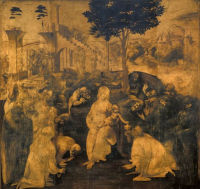Imagination and Invention Click on the thumbnails to explore the trail
Read more about this trail (expand)
The exercise of imaginative fantasy was as much an integral part of Leonardo’s mind as the discipline of scientific observation. For the artist, imagination was dependent upon an accurate understanding of observational input – a complete comprehension of the geometry of God’s design. Sensory impressions gained from observation were recombined by the artist’s ‘fantasia’ or imagination, to create new and credible forms

- Enlarge
- Zoom & explore
- © Soprintendenza Speciale Polo Museale Fiorentino
Adoration of the Magi c1479-81
By Leonardo’s time, the study of the life model was standard practice in the Renaissance artist’s workshop. The movements of the face and hands were particularly important as a means of conveying a person’s feelings. Leonardo has obviously studied these elements intensely before beginning this painting.
In the foreground, a writhing mass of figures surrounds the Madonna and Child. Leonardo has portrayed these “extras” in an astonishing variety of movements and gestures so that each conveys their own unique response to the arrival of God’s son on earth – wonder, awe, curiosity or disbelief. Their varied emotions cause them to move in different directions, as their heads turn this way and that. Despite this chaos, the attention of most is firmly focused on the Mother and her infant, who are calmly seated in the centre of the heaving crowd.
The peculiar individuality, range and expressive force of Leonardo’s figures supersedes anything produced by his contemporaries. In this unfinished painting, Leonardo has combined the power of his imagination with his knowledge of natural forms, to create a new and powerfully expressive type of art.
In Leonardo's words
If the painter wishes to see beauties which will enamour him, he is the lord of their production, and if he wishes to see monstrous things which frighten or those which are buffoonish and laughable or truly compassionate, he is their lord and god.
This unfinished altarpiece was originally commissioned by the monks of San Donato a Scopeto, a monastery near Florence, in March 1481. Leonardo’s father, who administered the monastery’s finances, may have played a role in obtaining the commission. The painting was left unfinished by Leonardo when he moved to Milan sometime before 1483.
In this painting, Mary is seated with the Christchild in the centre of the composition in front of a rocky landscape, surrounded by a large number of figures, the identity of which remains unclear (it is uncertain which figure is Joseph). In the foreground, the three kings who followed the Star of Bethlehem on their journey from the East, kneel in worship before the Christchild. In the background we can see the ruins of King David’s palace, alluded to in the Old Testament as the ancestor and precursor of Christ, and figures on horseback engaged in violent combat. These may be a reference to the enmity that was said to exist between the three kings, or to the chaos of the world prior to the coming of Christ.
Leonardo’s Adoration represents the moment when the second king offers his gift of frankincense, traditionally a symbol of the Eucharist, to the Christ-child who willingly receives it, a symbolic gesture of his acceptance of his fate.
- Medium Oil on wood panel
- Size 24.3 x 24.6 cm
- Location Galleria degli Uffizi












